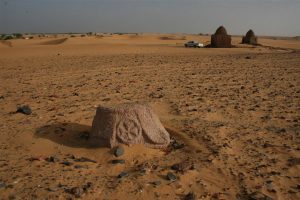A recent survey project in Northern Sudan, lead by archaeologists from The Archaeological Museum in Poznań in the region of the Letti Basin discovered numerous relics connected to settlements and graveyards dated back to the times of the Kingdom of Makuria. In the period of 6th to 14th century it was a thriving state stretching between the second and fifth Nile cataract extending far North, to the region of modern Asuan.

While the south part of the former Makurian state is well recognised due to the excavations of the Polish Centre of Mediterranean Archaeology of University of Warsaw, the Northern part is not with only a few sites noted, by fieldwork done by dr. Krzysztof Grzymski of Royal Ontario Museum.
As the initiator of the recent study, dr. Dobiesława Bagińska of the Archaeological Museum in Poznań states, in the Letti Basin region economic and cultural wealth flowing into the capital of Old Dongola originated. It could be a crucial area that aided the effort of this Christian kingdom to stop the invasion of muslim armies that conquered Egypt in the 7th cent.
One of the important sites found is Hag Magid, a large hill with covering over 1 hectare space. On its surface numerous pottery shards as well as Medieval architectural relics such as columns were found. The hill is 6 metres high and probably consists of many layers of settlement relics piling over through centuries, forming a typical tell (settlement mound) form. Ceramic pottery pieces dated to 7th-13th century indicate that the site might contain valuable archaeological resources. More fieldwork and geophysical research is planned for autumn.
(from Nauka w Polsce & Dobiesława Bagińska)